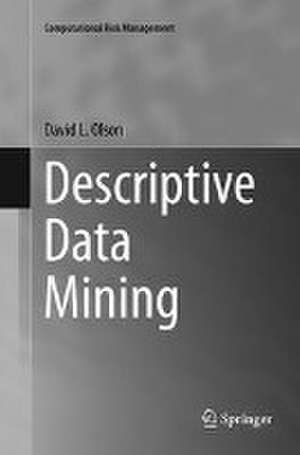Descriptive Data Mining: Computational Risk Management
Autor David L. Olsonen Limba Engleză Paperback – 5 iul 2018
This book offers an overview of knowledge management. It starts with an introduction to the subject, placing descriptive models in the context of the overall field as well as within the more specific field of data mining analysis. Chapter 2 covers data visualization, including directions for accessing R open source software (described through Rattle). Both R and Rattle are free to students. Chapter 3 then describes market basket analysis, comparing it with more advanced models, and addresses the concept of lift. Subsequently, Chapter 4 describes smarketing RFM models and compares it with more advanced predictive models. Next, Chapter 5 describes association rules, including the APriori algorithm and provides software support from R. Chapter 6 covers cluster analysis, including software support from R (Rattle), KNIME, and WEKA, all of which are open source. Chapter 7 goes on to describe link analysis, social network metrics, and open source NodeXL software, and demonstrates link analysis application using PolyAnalyst output. Chapter 8 concludes the monograph.
Using business-related data to demonstrate models, this descriptive book explains how methods work with some citations, but without detailed references. The data sets and software selected are widely available and can easily be accessed.
Preț: 694.16 lei
Preț vechi: 867.69 lei
-20% Nou
Puncte Express: 1041
Preț estimativ în valută:
132.84€ • 144.25$ • 111.59£
132.84€ • 144.25$ • 111.59£
Carte tipărită la comandă
Livrare economică 22 aprilie-06 mai
Preluare comenzi: 021 569.72.76
Specificații
ISBN-13: 9789811098475
ISBN-10: 9811098476
Ilustrații: XI, 116 p. 63 illus., 60 illus. in color.
Dimensiuni: 155 x 235 mm
Greutate: 0.19 kg
Ediția:Softcover reprint of the original 1st ed. 2017
Editura: Springer Nature Singapore
Colecția Springer
Seria Computational Risk Management
Locul publicării:Singapore, Singapore
ISBN-10: 9811098476
Ilustrații: XI, 116 p. 63 illus., 60 illus. in color.
Dimensiuni: 155 x 235 mm
Greutate: 0.19 kg
Ediția:Softcover reprint of the original 1st ed. 2017
Editura: Springer Nature Singapore
Colecția Springer
Seria Computational Risk Management
Locul publicării:Singapore, Singapore
Cuprins
Chapter 1 Knowledge Management.- Chapter 2: Data Visualization.- Chapter 3 Market Basket Analysis.- Chapter 4 Recency Frequency and Monetary Model.- Chapter 5 Association Rules.- Chapter 6 Cluster Analysis.- Chapter 7 Link Analysis.- Chapter 7 Link Analysis.- Chapter 8 Descriptive Data Mining.- References.- Index.
Notă biografică
David L. Olson is the James & H.K. Stuart Professor in MIS and Chancellor’s Professor at the University of Nebraska. He has published over 200 articles in refereed journals, primarily on the topic of multiple objective decision-making and information technology. He has authored over 20 books, is co-editor-in-chief of the International Journal of Services Sciences and associate editor of a number of journals. He has given over 150 presentations at international and national conferences. He is a member of the Decision Sciences Institute, the Institute for Operations Research and Management Sciences, and the Multiple Criteria Decision Making Society. He was a Lowry Mays endowed Professor at Texas A&M University from 1999 to 2001, was named the Raymond E. Miles Distinguished Scholar in 2002, and was James C. and Rhonda Seacrest Fellow from 2005 to 2006. He was named Best Enterprise Information Systems Educator by IFIP in 2006. He is a Fellow of the Decision Sciences Institute.
Textul de pe ultima copertă
This book offers an overview of knowledge management. It starts with an introduction to the subject, placing descriptive models in the context of the overall field as well as within the more specific field of data mining analysis. Chapter 2 covers data visualization, including directions for accessing R open source software (described through Rattle). Both R and Rattle are free to students. Chapter 3 then describes market basket analysis, comparing it with more advanced models, and addresses the concept of lift. Subsequently, Chapter 4 describes smarketing RFM models and compares it with more advanced predictive models. Next, Chapter 5 describes association rules, including the APriori algorithm and provides software support from R. Chapter 6 covers cluster analysis, including software support from R (Rattle), KNIME, and WEKA, all of which are open source. Chapter 7 goes on to describe link analysis, social network metrics, and open source NodeXL software, and demonstrates link analysis application using PolyAnalyst output. Chapter 8 concludes the monograph.
Using business-related data to demonstrate models, this descriptive book explains how methods work with some citations, but without detailed references. The data sets and software selected are widely available and can easily be accessed.
Caracteristici
Includes a discussion of descriptive analytic modeling Covers visualization in the context of data mining Demonstrates modeling with R and other open source software products Includes supplementary material: sn.pub/extras








